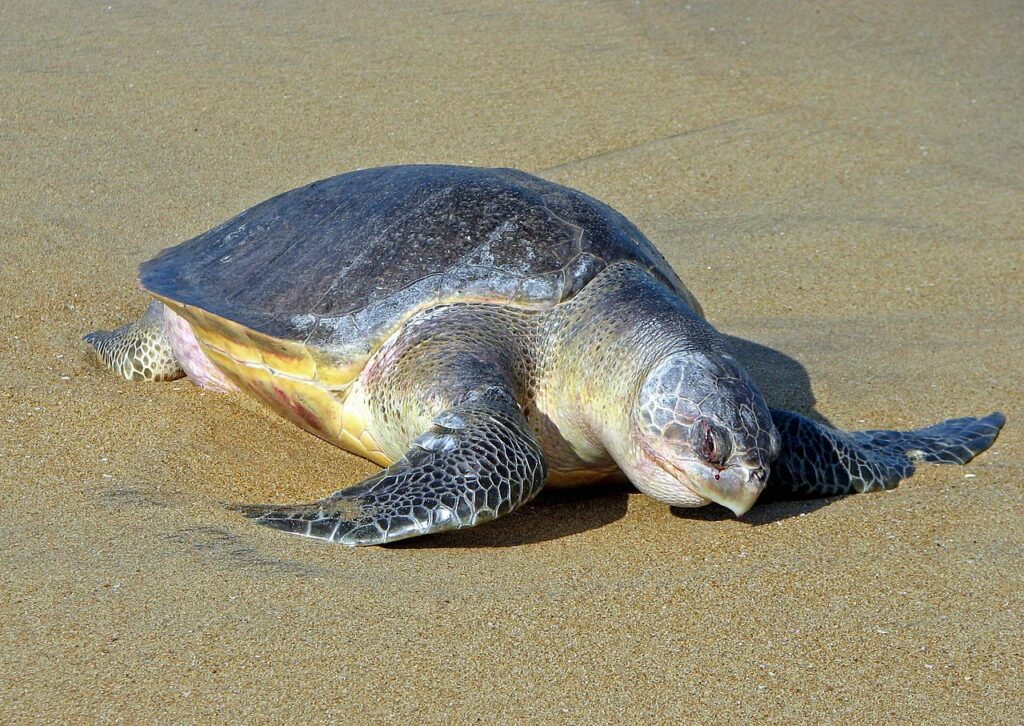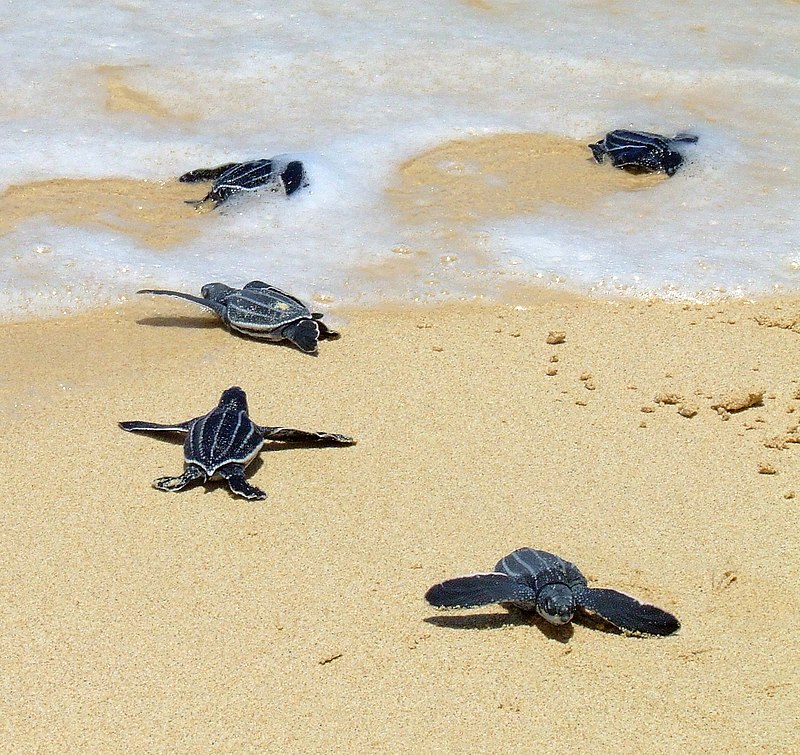The subject of dinosaurs has always fascinated the curious mind. Realising that they are now extinct renders the heart rather broken. However, all is not lost, when it is revealed that some animals who co-existed with dinosaurs, still walk on this very planet. This living fossil are the seven species of marine turtles! Quite unbelievable, the first turtle was born about 130 million years ago. Modern species originated between 60 to 10 million years ago. Unfortunately we are severely destroying their habitats.
Which species of Marine Turtles are found in India?
- Olive Ridley turtle (Lepidochelys olivacea)
This is the most common turtle in India. They are found on the Eastern coast during the breeding season from January to March.

- Green turtle (Chelonia mydas)
The Green turtle can be spotted on the Western and Eastern coast as well as on the islands.
- Hawksbill turtle (Eretmochelys imbricata)
This is a small-sized turtle and relatively less abundant than the others. Found on the Lakshadweep and Andaman and Nicobar Islands, its diet consists of sponges, crabs and molluscs. Since most of its prey is poisonous, its flesh is also considered to be poisonous.
- Loggerhead turtle (Caretta caretta)
This is a reddish-brown turtle with a significantly large head, hence the name. It is spotted in the Gulf of Mannar and is also a carnivore.
- Leatherback turtle (Dermochelys coriacea)
This is one of the bulkiest animals ever, weighing as much as 500kg. Its name comes from the leathery tissue which covers the bones on its shell. It can be seen visiting the Andaman and Nicobar Islands.

Remarkably, their appearance, habitat and diet have rarely changed since so many millions of years. Some species weighing as much as 500 kg, sea turtles are equipped with flippers which help them swim, and come on shores and beaches during breeding and nesting season. In India, they are found on the Western and Eastern coasts, as well as on the Lakshadweep and Andaman and Nicobar Islands. They have become quite the sight to look at, and also a major touristic attraction. However, this was not always the case 50 years ago…
What threats do Marine Turtles face in India?
The sea turtle has endured many problems since a long time. It has been threatened by many anthropogenic issues. Firstly, it was hunted for its meat not only by indigenous populations but also by hunters. Additionally, due to illegal trade of its eggs and poaching for its shell and leather, the turtle’s population has dwindled drastically. The turtle’s community is also indirectly affected by infrastructural developments such as sand mining, coastal deforestation, resulting in habitat loss and fragmentation. Furthermore, turtles suffer immensely from being bycatch, i.e., accidently being caught by fishermen in their fishing gears. On the other hand, plastic pollution and other waste have started to suffocate turtles as well as their survival, too. In short, all these problems, resulting in climate change, have led to the endangerment of marine turtles.
Ecological Importance of Marine Turtles
Sea turtles have a strong ecological role in their habitat. For example, by feeding on jellyfish, sea turtles keep their population in control, thus affecting the organisms which the jellyfish feeds on. This makes them an important deciding factor in the ecosystem: a keystone species. Green turtles are known to feed on seagrass and crop the plants, providing breeding and nursing grounds for a myriad of fish species. Hawksbill turtles perform a similar function by feeding on sponges, to clear up the reef ecosystem. Sea turtles are also important for the fight against climate change, as they are the key vectors to transport nutrients and energy to and from the coastal regions and oceanic zones, storing harmful elements like carbon along the way.
Consequently, to protect sea turtles from extinction and to give them the respect they deserve, there have been numerous initiatives carried out by countries around the world. India aims to conserve existing turtle populations by focussing on protecting and preserving coastal zones of the country. Here are some projects carried under various schemes:
What is being done to conserve Marine Turtles in India?
Legal Protection
- Wildlife Protection Act
This act established in 1972, aims to shelter wild animals, birds and plants all over the subcontinent, including sea turtles which come on the Western and Eastern coasts. India has also declared 4 coastal mainland National Parks and 17 Protected Areas to enhance protection.
- National Marine Turtle Action Plan
The ‘Marine Mega Fauna Stranding Guidelines’ and National Marine Turtle Action Plan’ by the Ministry of Environment, Forests and Climate Change (MoEF&CC) aim to start an inter-regional project which will connect the Central, State governments and the general civil society, to educate and make aware of threats to marine animals such as sea turtles. These acts aim to take action to reduce threats, rehabilitate degraded ecosystems, increase contribution from the public as well as continue research and spread awareness about marine animals.
Conservation Projects
- Sea Turtle Project
Started in 1999, this project is a joint venture by the Government of India and the UNDP, with the Wildlife Institute of India coordinating various programs, it aims to protect turtle populations by raising awareness, conducting surveys and reviews, GIS studies of nesting areas, TED (Turtle Excluding Devices, used to help turtles escape trawl nets) demonstrations and training for field workers. It works on Olive Ridley turtles on the Eastern coast, mainly in Odisha.
- Recovery program
The Central Marine Fisheries Research Institute has started this project along the coast in Chennai, mainly to protect olive ridley turtle hatchlings which have high mortality rates due to threats from humans as well as other predators. Up till now, 60,410 Olive Ridley hatchlings have hatched out at the CMFRI field laboratory, showing hope to the populations of this vulnerable species.
- Establishment of the Gahirmatha Marine Sanctuary in Bhitarnika Wildlife Sanctuary
Now the largest turtle nesting site in Indian ocean and Odisha’s only turtle sanctuary, the Gahirmatha Marine Sanctuary, established in 1997, has been an immediate success to rehabilitate to olive ridley turtles. It has equally become a great attraction for tourists all over the world, especially for birdwatching.
- Sahyadri Nisarga Mitra
This organisation is one of the main turtle conservation initiatives to work on turtle conservation on the Western coast. Passionate about wildlife conservation, the organisation started the Marine Turtle Conservation scheme to protect hatchlings of sea turtles found on the Konkan coast. With the huge success of this project, this organisation now hosts the nation-wide famous ‘Turtle Festival’ in coastal regions like Velas, to educate populations about the importance of protection of baby turtles.
Conclusion
With such unique and strong initiatives taking place, mass awareness of the civil society takes place, and thus, through simple activities like tourism and educational sessions, humans will still be able to prevent the threats faced by sea turtles, paving the way for a safer future for them!
Written by: Shreya Patankar
Help us Help Them! Think Wildlife Foundation is a non profit organization with various conservation initiatives. Our most prominent campaign is our Caring for Pari intiative. Pari is a rehabilitated elephant at the Wildlife SoS Hospital. 25% of the profits from our store are donated to the elephant hospital for Pari. Other than buying our wonderful merchandise, you could donate directly to our Caring For Pari fundraiser.
